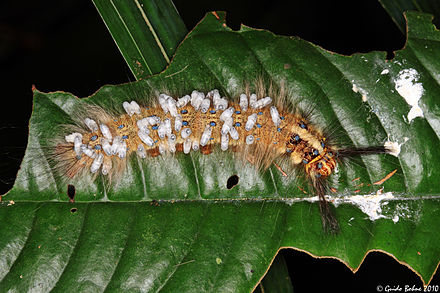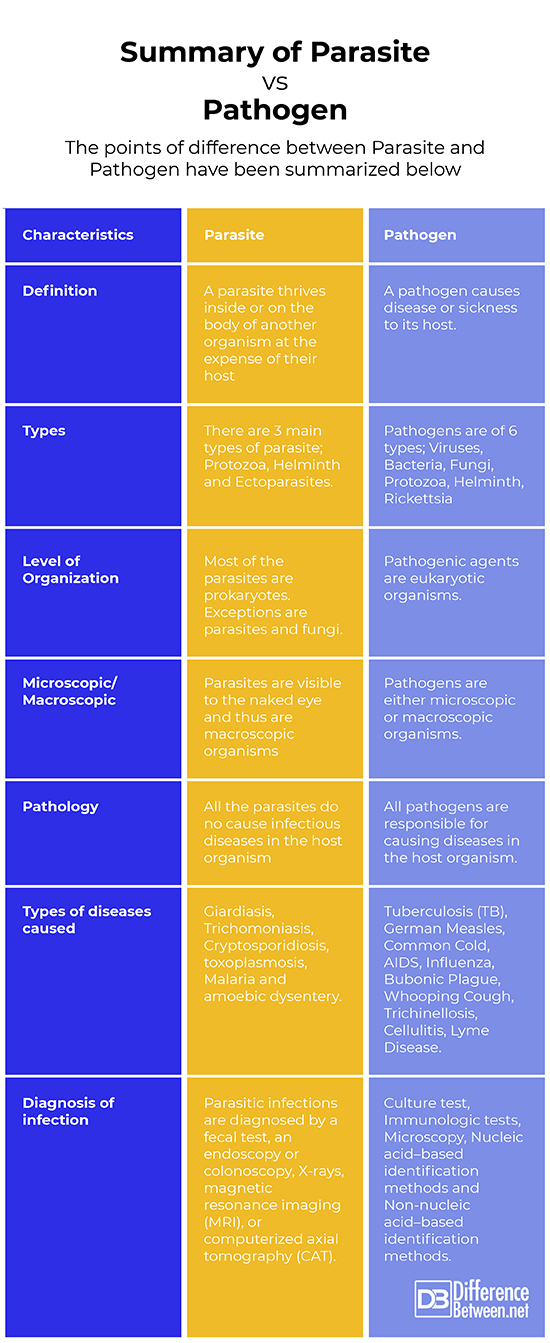Difference Between Parasite and Pathogen
What is Parasite and Pathogen?
These are two types of organisms that can be dangerous to hosts. Both parasites and pathogens are disease causing agents in the host organisms. Both are specific to the host and possess high multiplication rates.
The major difference between a parasite and a pathogen is that parasite can be a category of pathogen whereas pathogens are disease-causing organisms in the host. However, not all parasitic organisms are pathogens.
What is Parasite?
A parasite is an organism that lives inside or on another organism called the host organism and benefits at the expense of the host. Ideally, parasites are the organisms that can be seen with naked eye. Therefore, parasites are macroscopic organisms. Examples include Protozoans and helminths. Also, parasites are host specific. Hence, they can cause sickness in specific organisms. Approximately, thirty-six thousand and four hundred species of protozoans have been reported as pathogens in other living organisms. On the other hand, about seventy species of protozoans and three hundred species of helminths are identified as parasites in humans. Among them, about ninety species are responsible for causing sickness in humans. So, it can be said that all parasites are not responsible for causing diseases in humans. Plasmodium is one of the examples of protozoan, which is a known parasite in humans.
Parasites have diverse-means of transmission in disease endemic areas, many including complex interrelationships between the host, parasite, vector, and environmental elements.
What is Pathogen?
Pathogens are disease causing agents. They cause sickness to their host. Examples include virus, bacterium, fungus, prion or parasite. The host organism could be an animal, plant, or a microorganism. Bacteria are as tiny as 10 μm in size and are responsible for health issues like typhoid, gonorrhea, cholera and food poisoning. Pathogens like viruses are even smaller than the bacteria. Viruses replicate and multiply only inside the host cell. The diseases caused by viruses include HPV (warts), influenza, yellow fever, Herpes 1 and 2, common cold, Rubella, Dengue fever and AIDS. Another pathogen type are Fungi that are also eukaryotic organisms. Fungal infections include Aspergillosis, Blastomycosis, Candidiasis, jock itch and athlete’s foot.
Difference between Parasite and Pathogen
Definition
Parasite
Parasites are disease causing agents that live on or inside the body of other organisms and thrive to harm their host.
Pathogen
A pathogen is an organism that causes disease to its host.
Types
Parasite
There are 3 main types of parasites.
- Protozoa: These are single celled eukaryotes. Protozoa are found everywhere i.e. they are ubiquitous. A protozoon multiplies or divides within the host. Types of protozoa include Ciliates, Flagellates, Sporozoans and Sacrodines.
- Helminths: These are the parasitic worms like roundworm, tapeworm, pinworm, trichina spiralis, and fluke. These are large macro-parasites and feed on a live host organism to get nutrients, energy and protection, while resulting in poor nutrient absorption, sickness, fatigue and disease in the host. These are intestinal worms and can be seen in the small bowel.
- Ectoparasites: These parasites live on the outside of the host organism from which they thrive their sustenance. The ectoparasites include lice and fleas.
Pathogen
Pathogens are of 6 types;
- Viruses: These are tiny infection causing agents that multiplies only inside the cells of the host body. It comprises DNA and RNA genome in the interior of a protein shell known as capsid. Viruses have the potential to infect all types of life forms, plants to animals to microorganisms. These can cause mild to severe illness in humans, animals and plants.
- Bacteria: Bacteria consist of single cells (prokaryotes) that can thrive in diverse environments. They are just few micrometers in length and have different shapes like rod, spirals and spheres. Diseases associated with bacteria include fever, chills, inflammation of the lungs, shortness of breath and cough.
- Fungi: These pathogens include yeast, mold and mushroom. These are single celled or multi-celled parasitic organism.
- Protozoa: These are single-celled tiny organisms that produce disease causing toxins. Diseases caused by protozoans include Malaria.
- Helminth: These are parasitic worms which are visible to naked eye. These feed on a live host to get energy, nutrients and protection and cause sickness, fatigue, disease in the host. Example is Tapeworm.
- Rickettsia: These are pathogens which grow inside living cells and are similar to bacteria. Example is Typhus.
Types of Diseases Caused
Parasite
- Giardiasis
- Malaria
- Amoebic dysentery
- Babesiosis,
- Anaplasmosis
- Dermatophilosis
- Theileriosis
Pathogen
- Common cold
- Influenza
- AIDS
- Tetanus
- Food poisoning
Symptoms
Parasite
- Abdominal pain/cramping
- Allergies
- Anemia
- Change in bowels
- Skin problems
- Diarrhea, nausea, or vomiting
- Unexplained weight loss
- Joint pain or hives
- Gas/bloating
- Dizziness
- Fatigue
- Constipation
Pathogen
- Feelings of Malaise
- High fever
- Headache
- Redness, rash and Swelling
- Fluid drainage
- Hot Incision Site
- Muscle soreness
Levels of Organization
Parasite
Most of the parasites are prokaryotic organisms. A prokaryote is a unicellular organism that does not have a membrane-bound nucleus and mitochondria. Except Fungi and parasites.
Pathogen
Pathogens are eukaryotic organisms. Eukaryotes are the organisms in which the cells have a nucleus with their membranes, unlike prokaryotes.
Summary of Parasite Vs. Pathogen
The points of difference between Parasite and Pathogen have been summarized below:
- Difference Between Global Warming and Greenhouse Effect - May 18, 2024
- Difference Between Vaccination and Immunization - March 3, 2024
- Difference Between Selective Mutism and Autism - February 25, 2024
Search DifferenceBetween.net :
Leave a Response
References :
[0]Alberts, B., Johnson, A., Lewis, J., Raff, M., Roberts, K., & Walter, P. (2002). Introduction to pathogens.
[1]Dimijian, G. G. (2000, January). Pathogens and parasites: strategies and challenges. In Baylor University Medical Center Proceedings (Vol. 13, No. 1, pp. 19-29). Taylor & Francis.
[2]Méthot, P. O., & Alizon, S. (2014). What is a pathogen? Toward a process view of host-parasite interactions. Virulence, 5(8), 775-785.
[3]Image credit: https://en.wikipedia.org/wiki/Parasite_load#/media/File:Lappet_moth_caterpillar_parasited_by_braconid_wasps_(Apanteles_sp.)_(5050724084).jpg
[4]Image credit: https://pixabay.com/en/bacteria-pathogen-infection-green-426997/



